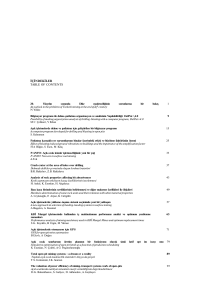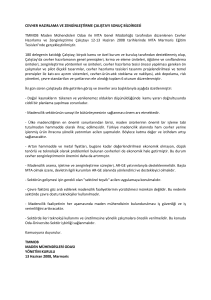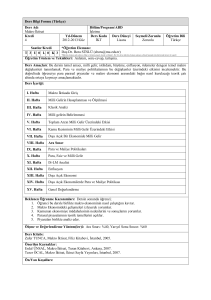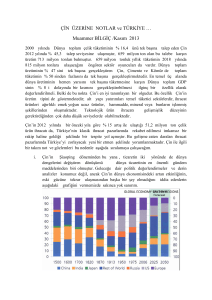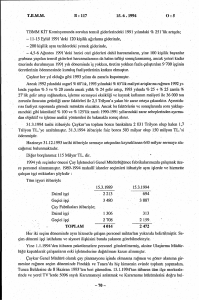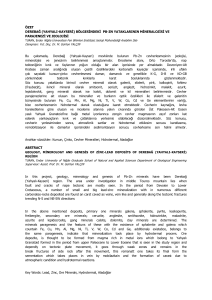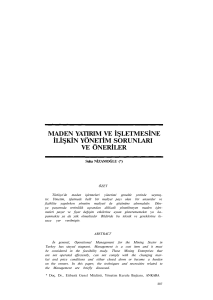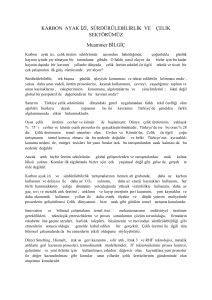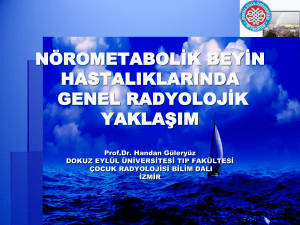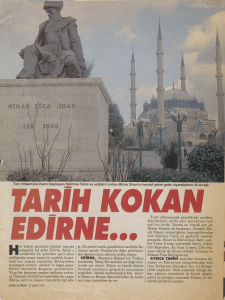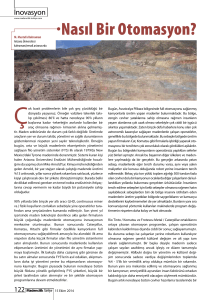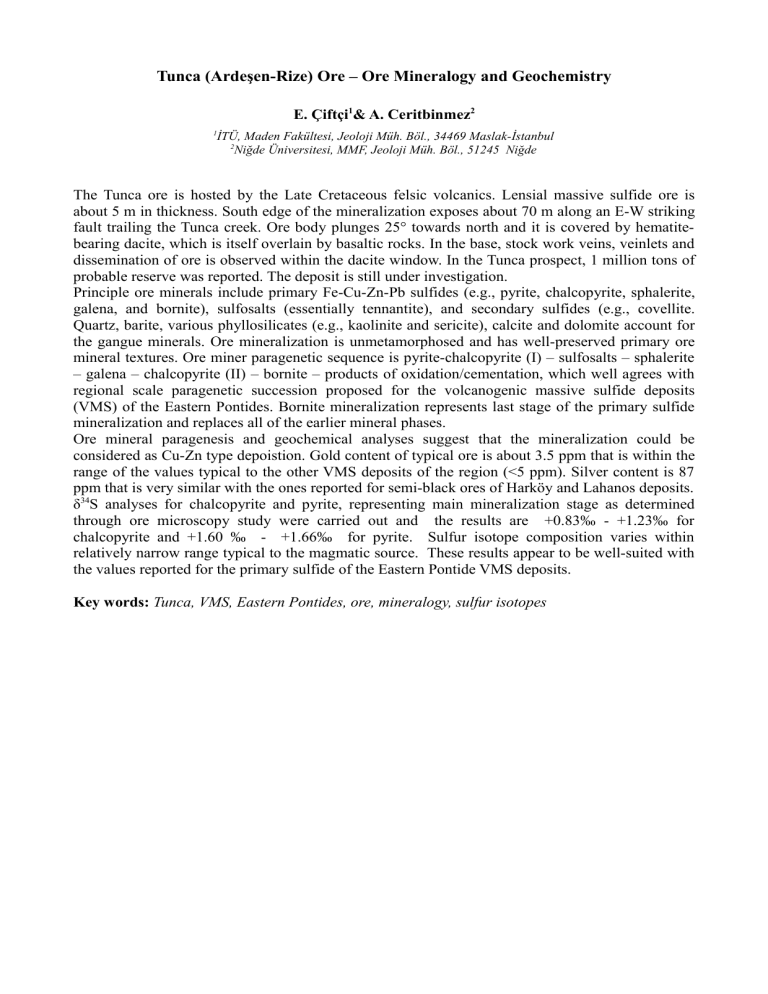
Tunca (Ardeşen-Rize) Ore – Ore Mineralogy and Geochemistry
E. Çiftçi1& A. Ceritbinmez2
1
İTÜ, Maden Fakültesi, Jeoloji Müh. Böl., 34469 Maslak-İstanbul
2
Niğde Üniversitesi, MMF, Jeoloji Müh. Böl., 51245 Niğde
The Tunca ore is hosted by the Late Cretaceous felsic volcanics. Lensial massive sulfide ore is
about 5 m in thickness. South edge of the mineralization exposes about 70 m along an E-W striking
fault trailing the Tunca creek. Ore body plunges 25° towards north and it is covered by hematitebearing dacite, which is itself overlain by basaltic rocks. In the base, stock work veins, veinlets and
dissemination of ore is observed within the dacite window. In the Tunca prospect, 1 million tons of
probable reserve was reported. The deposit is still under investigation.
Principle ore minerals include primary Fe-Cu-Zn-Pb sulfides (e.g., pyrite, chalcopyrite, sphalerite,
galena, and bornite), sulfosalts (essentially tennantite), and secondary sulfides (e.g., covellite.
Quartz, barite, various phyllosilicates (e.g., kaolinite and sericite), calcite and dolomite account for
the gangue minerals. Ore mineralization is unmetamorphosed and has well-preserved primary ore
mineral textures. Ore miner paragenetic sequence is pyrite-chalcopyrite (I) – sulfosalts – sphalerite
– galena – chalcopyrite (II) – bornite – products of oxidation/cementation, which well agrees with
regional scale paragenetic succession proposed for the volcanogenic massive sulfide deposits
(VMS) of the Eastern Pontides. Bornite mineralization represents last stage of the primary sulfide
mineralization and replaces all of the earlier mineral phases.
Ore mineral paragenesis and geochemical analyses suggest that the mineralization could be
considered as Cu-Zn type depoistion. Gold content of typical ore is about 3.5 ppm that is within the
range of the values typical to the other VMS deposits of the region (<5 ppm). Silver content is 87
ppm that is very similar with the ones reported for semi-black ores of Harköy and Lahanos deposits.
δ34S analyses for chalcopyrite and pyrite, representing main mineralization stage as determined
through ore microscopy study were carried out and the results are +0.83‰ - +1.23‰ for
chalcopyrite and +1.60 ‰ - +1.66‰ for pyrite. Sulfur isotope composition varies within
relatively narrow range typical to the magmatic source. These results appear to be well-suited with
the values reported for the primary sulfide of the Eastern Pontide VMS deposits.
Key words: Tunca, VMS, Eastern Pontides, ore, mineralogy, sulfur isotopes
Tunca (Ardeşen-Rize) Cevheri – Cevher Mineralojisi ve Jeokimyası
Tunca cevheri Üst Kretase yaşlı felsik volkanitler tarafından içerisinde bulunmaktadır. Mercek
biçimindeki masif sülfür yataklanması ortalama 5 m kalınlıktadır. Güney kenarı, Tunca deresini
takip eden doğu-batı yönlü bir fay boyunca 70 m boyunda yüzeylenme göstermektedir. Kuzeye
doğru yaklaşık 25°’lik bir eğimle dalan masif cevher kütlesi, hematitli bir dasit birimi ile örtülmekte
ve bu dasit birimini de üzerleyen bazaltlar bulunmaktadır. Altta asıl cevher yan kayacını oluşturan
bir dasit penceresi içinde ağsal damar ve damarcık ile saçılımlı cevher zonları bulunmaktadır. Tunca
yatağında 1.000.000 ton muhtemel rezerv tespit edilmiştir. Sahada halen arama çalışmaları devam
etmektedir.
Ana cevher mineralleri, birincil Fe-Cu-Zn-Pb sülfürler (esas olara pirit, kalkopirit, sfalerit, galen,
bornit), sulfotuzlar (esas olarak tenantit), ikincil sülfürler (kovelit gibi)’den oluşurken, gang
mineralleri olarak kuvars, barit, çeşitli filosilikatlar mineralleri (kaolinit ve serisit gibi), kalsit ve
dolomit gözlenmektedir. Cevherleşme metamorfize olmamış ve iyi-korunmuş birincil cevher
dokularına sahiptir. Cevher mineral süksesyonu pirit- kalkopirit (I) – sulfotuzlar (tenantit) – sfalerit
- galen-kalkopirit (II)-bornit-oksidayon/sementasyon ürünleri olarak belirlenmiş ve bu bölgesel
ölçekte Doğu Pontidlerdeki volkanojenik masif sülfür yatakları için önerilen parajenetik
süksesyonla oldukça uyumludur. Bornit cevherleşmesi primer sülfit cevherleşmesinin son
safhasında gerçekleşmiş olup, erken bütün fazları ornatmaktadır.
Cevher mineral parajenezi ve jeokimyasal analizler cevherleşmenin Cu-Zn-tipinde
sınıflanabileceğini önermektedir. Tipik cevherdeki altın içeriği 3.54 ppm olup, bölgedeki diğer
masif sülfür yataklarına benzerlik göstermektedir (<5 ppm). Gümüş içeriği 87 ppm olup, bölgedeki
diğer yarı siyah cevher içeren Harköy ve Lahanos yataklarına ait değerlerle büyük benzerlik
sunmaktadır.
δ34S izotop analizleri ana cevherleşme parajenezine ait olduğu, cevher mikroskobu çalışması ile
belirlenmiş olan kakopirit ve pirit üzerinde yapılmış ve kalkopirit için ‰ +0.83 ila ‰ +1.23
arasında değerler, pirit için ‰ +1.60 ila ‰ +1.66 arasında değerler bulunmuştur. Kükürt izotop
bileşimleri nispeten dar aralıkta değişim göstermekte ve kükürt için magmatik kökeni ima
etmektedir. Bu değerler aynı zamanda doğu Pontidlerdeki diğer majör masif sülfür yatakları ile
oldukça uyumlu gözükmektedir.
Anahtar kelimeler: Tunca, VMS, Doğu Pontitler, cevher, mineraloji, kükürt izotopları

